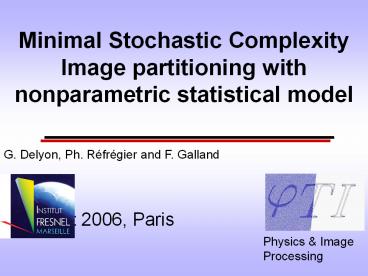Minimal Stochastic Complexity Image partitioning with nonparametric statistical model - PowerPoint PPT Presentation
Title:
Minimal Stochastic Complexity Image partitioning with nonparametric statistical model
Description:
Parametric statistical models ... From Ukraine. Criterion: Comparison with parametric approaches. Algorithm adapted to Gamma PDF ... – PowerPoint PPT presentation
Number of Views:48
Avg rating:3.0/5.0
Title: Minimal Stochastic Complexity Image partitioning with nonparametric statistical model
1
Minimal Stochastic Complexity Image partitioning
with nonparametric statistical model
G. Delyon, Ph. Réfrégier and F. Galland
MaxEnt 2006, Paris
Physics Image Processing
2
Overview
1. Introduction to image segmentation
2. Stochastic Complexity and application to
parametric statistical techniques
3. Novelty of the work nonparametric
statistical technique
2
3
Overview
1. Introduction to image segmentation
2. Stochastic Complexity and application to
parametric statistical techniques
3. Novelty of the work nonparametric
statistical technique
3
4
Noisy image segmentation
Goal to automatically recover the shape of
objects in noisy images
ESA 1993 Distribution Spot Image
4
agricultural fields (Bourges, France)
5
Noisy image segmentation
In general one needs to - choose a probability
model for the grey level fluctuations
Example SAR image gt Gamma Probability Density
Function (PDF)
- adjust parameters to control the regularity of
the boundaries
5
6
Overview
1. Introduction to image segmentation
2. Stochastic Complexity and application to
parametric statistical techniques
3. Novelty of the work nonparametric
statistical technique
6
7
Introduction to Stochastic Complexity
For example to fit data one can choose a
polynomial of order M
- Choice of the order M of the polynomial
- trade-off between the complexity of the model
and the error between the data and the model
Measurements
7
8
Stochastic complexity
Model complexity
8
9
Application to segmentation in homogenous regions
Best segmentation in the stochastic complexity
sense ltgt segmentation which allows one to get
the best compression with a Shannon code.
- To apply this principle one thus needs
- to choose a probabilistic image model
- to determine the code length associated to a
given segmentation - to find the segmentation which minimizes this
length
9
10
Polygonal grid
Polygonal grid
R (unknown) regions
10
F. Galland, N. Bertaux and Ph. Réfrégier. IEEE
IP, pp. 995-1006 September 2003.
11
Parametric statistical models
Probability Density Functions (PDF) of the grey
levels are assumed to belong to the exponential
family (for example Gaussian or Gamma or
Poisson, etc).
- gt - no parameter
- - no EM technique since the explicit
expression of the profile - likelihood is known in most of the PDF in
the exponential family
11
12
Parametric statistical models
Segmentation result obtained with the algorithm
adapted to Gamma PDF
12
13
Limitations of the parametric approach
- Constraints
- knowledge of the PDF family in each region
strong hypothesis, - images for which a parametric description
(Gaussian, Gamma, Poisson, ) of the grey levels
fluctuations is not available.
13
14
Overview
1. Introduction to image segmentation
2. Stochastic Complexity and application to
parametric statistical techniques
3. Novelty of the work nonparametric
statistical technique
14
15
Nonparametric statistical model
Estimation of the Probability Density Functions
(PDF) of the grey levels with irregular step
functions
Region B
Region A
Pb(j)
Pa(j)
s
s
aj1
aj
Grey levels
aj1
Grey levels
aj
15
16
Determimation of the aj
Start with a regular histogram sampling
Nj
Nj
Histogram
Histogram
s
s
Grey levels
Fusion of two steps if it allows one to decrease D
16
17
Optimization procedure
Stage 3
Stage 1
Stage 2
SAR image segmentation result obtained with the
step functions. Image courtesy of the
NASA/JPL-Caltech AIRSAR system.
17
18
Relevance of the proposed approach
Comparison with standard approaches (Mumford and
Shah energy function or Zhu and Yuille criterion)
DE external energy
DI internal energy
l regularization parameter
18
19
Relevance of the proposed approach
19
20
Relevance of the proposed approach
l 0.3
l 0.5
l 0.75
20
21
Relevance of the proposed approach
l 0.2
l 0.5
l 0.85
21
22
Relevance of the proposed approach
- 0.5
- is the optimal value
22
23
Illustration of the result on a real image
SAR image provided by the CNES and the ESA
23
24
Comparison with parametric approaches
G. Delyon and Ph. Réfrégier, IEEE Geoscience, 44
(7), pp. 1954-1961, July 2006.
24
25
Comparison with parametric approaches
Segmentation results obtained on the hue
component of the HSV representation
G. Delyon, F. Galland and Ph. Réfrégier, IEEE IP,
15 (10), October 2006, to appear.
25
26
Conclusion
- The Stochastic Complexity allows one to
- - write the likelihood and the regularization
terms in the same unit (number of bits) so that
the weighting is optimal considering a quality
segmentation criterion, - - define a segmentation technique based on
the minimization of a criterion without parameter
to be tuned by the user, - - take into account the grey levels
fluctuations without making hypotheses on the PDF
family of the noise.
26
27
27
28
Polygonal grid
To encode a segmented image, one needs to encode
the grid, the pdf parameters, and the pixel
grey levels in each region
Grid encoding
PDF parameters encoding
Pixels grey levels encoding
( ML estimate)
No free parameter in the criterion to optimize
28































